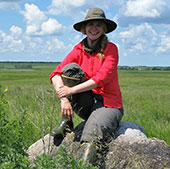Graduate Students
Main Content
Ashlee Minor
Email: ashlee.minor@siu.eduAdvisor: Dr. Mike Eichholz
Research Interest:
 Influence of Landscape and Vegetation Cover on Grassland Bird Productivity and Community Ecology in the Prairie Pothole Region
Influence of Landscape and Vegetation Cover on Grassland Bird Productivity and Community Ecology in the Prairie Pothole Region
Declines in numerous populations of grassland nesting birds are thought to be caused by declines in productivity due to loss and degradation of native grassland habitat. Many conservation organizations including the United States Fish and Wildlife Service (USFWS) and state agencies including North Dakota Game and Fish Department (NDGF) have acquired lands with previous cropping histories with the management purpose of providing planted habitat for nesting waterfowl. Recently, restoration practices have shifted towards species-rich native plantings using a seeding mix of 16-32 native species. This new approach of species-rich native plantings is more consistent with ecologically-based habitat restoration objectives, provides the potential for long-term cost efficiency, and should provide productive nesting habitat for grassland passerines and waterfowl when planted in landscapes with abundant grassland and high wetland densities. Therefore, conservation agencies are beginning to implement this restoration activity at landscape-levels (i.e., Prairie Pothole Region). However, the science behind successfully establishing high-diversity native vegetation plantings is still emerging, and greater understanding of the influence of species-rich native plantings on grassland nesting bird populations and the interacting wildlife communities must be developed before this restoration technique becomes a regular management practice.
The goal of my research is to better understand the influence that vegetation cover type has on grassland bird nesting success by gaining an understanding of the effects that vegetation cover has on the interacting wildlife communities. Understanding, the community-level effects of vegetative cover on grassland bird productivity is necessary to identify management practices that best promote suitable breeding habitat for grassland birds. Results of this study will provide insight into how alternative prey, predators, and grassland bird productivity respond to different vegetation cover types that are currently being planted to restore grassland habitat. This information can then be used to optimize future grassland management practices for grassland nesting bird productivity and other Species of Conservation Priority (SoCP).



